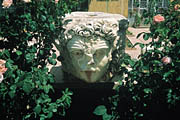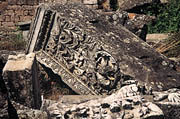

There are two sites that are of particular interest to those of us who are fascinated by the ancient stone and marble cities and monuments. Aphrodisias, dedicated to Aphrodite, the goddess of beauty and love, was a gathering point for the intellectuals of the Roman Empire, but it was also known as a center for stone sculpture. Ephesus, once a thriving commercial port city on the Aegean, today offers visitors the most complete ruins of any Roman Empire site.

Aphrodisias
Located approximately 140 miles southeast of present-day Izmir, the ruins of Aphrodisias stand somewhat isolated yet magnificent in the stories they tell to archaeologists as well as visitors. The city flourished from about the 3rd century BC through the 7th century and was the center for the cult of Aphrodite. Temples, baths, theatres, marketplaces and meeting places were all part of a thriving and sophisticated culture that pursued scientific and philosophical interests and attracted pilgrims and visitors from all over the Roman world.With marble quarries only a short distance away and supplies readily available, the city was known for its sculpture and ornamental carvings. Archaeological excavations located a stone sculptor's workshop at the heart of the city, where a set of stone-carving tools and a large quantity of sculpture in various stages of completion were found. The finds in the workshop indicated that the sculptors probably specialized in portraits and works in a range of sizes from statuette to larger than life. Other excavations uncovered statues of gods, emperors, and philosophers as well as grave reliefs from the 2nd century BC and statues of the last Roman governors of the 6th century.
The stone sculptors of Aphrodisias were known throughout the Mediterranean region for their energetic and distinctive style, and they traveled extensively to complete the commissions they received. Archaeological studies published after World War II documented the signatures on excavated sculptures and found that they corresponded with others found throughout the Roman world.
But sculpture wasn't the only attraction in Aphrodesias. The buildings and structures of the city all served specific commercial, religious or entertainment purposes.
The Temple of Aphrodite was the center and main attraction of the city. Celebrations were held with dancing and athletic events, and sacrifices were made in hopes of favors of love returned. Ovid's story of Pygmalion (our present-day Broadway musical "My Fair Lady") is of a sculptor who fell in love with his sculpture, which Aphrodite brought to life for him. The temple itself had 13 columns on each side and eight columns at the front and back, with statuary of the goddess positioned in niches in the interior. Stone sculptors decorated the temple in Ionian style, with intricately carved reliefs of gods and goddesses frolicking in lush gardens. Donors who gave columns to the temple had their names carved in the bases, much like the modern day practice of selling engraved commemorative bricks or stones in walls or walkways. Construction began in the 1st century BC and was completed early in the 1st century AD. Today, all that remains of the temple are 14 of the Ionic columns that once surrounded it.
Of all the ancient stadiums in the Mediterranean region, the one at Aphrodisias is the most impressive and best preserved. It seated 30,000 people for gladiator games, athletic competitions, circuses and animal shows. Its elliptical shape offered spectators unobstructed views of the action. The arcades and wall on the northeast side were incorporated into the city's defense system when the city walls were built.
Excavations of the theatre began in 1966 and uncovered well-preserved sections as well as a number of statues and carved reliefs. Built by the Greeks, the theatre was originally carved out of part of the Acropolis and completed in the year 27 BC. Structural changes were made by the Romans in the 2nd century to accommodate gladiatorial combats, and a room was added for staging the wild animals that were a part of these gruesome battles. Earthquakes in the 4th century damaged the structure, and over the course of time, the theatre was filled with rubble, and houses were built on top of it.
During in excavation of the theatre, the most important discoveries were the inscriptions carved in the stone walls that documented much of the history of the city. The Greek inscriptions included letters from Roman leaders and emperors, while others were part of the senatorial decree that gave Aphrodisias special status -- the city was a tax-free zone, and asylum rights in Aphrodite's temple were granted.
A combination of events in the years just before the 7th century lead to the city's decline. The spread of Christianity changed the status of the city, and the cult of Aphrodite declined in importance. Arab raids, religious disputes, political and economic changes and epidemics all contributed to the decline of the city. A devastating earthquake in the 7th century destroyed or severely damaged most of the important buildings, and the city never recovered.
Today, Aphrodisias is an active archaeological site that welcomes visitors to tour the area and spend time among the ruins and the museum that houses the important sculptures and architectural and ornamental carvings that have been excavated over the years.

Ephesus
The stones speak in Aphrodisias, but they are even more eloquent in Ephesus, cult center for the mother-goddess Artemis and the Roman capital of Asia Minor.The history of Ephesus can be traced back more than 4,000 years; however, the monumental ruins that tourists visit today date mostly from about 2,200 years ago, when the city came under Roman rule. Before the Romans, the city was ruled by a "Who's Who" of ancient conquerors -- the Lydian King Croesus, Persian King Cyrus and the Macedonian Alexander the Great.
As Ephesus grew in wealth and power in the 1st century, it underwent a building boom. Elegant marble-paved streets, vast agoras and marketplaces, a stadium, temples, public baths and a magnificent theatre all graced the city that, as the provincial capital, was the trading and banking center for Asia Minor. The city's inhabitants enjoyed intellectual, philosophical and artistic pursuits as well as religious freedom. The streets were illuminated at night by oil burning lamps, contributing to a lively night life that included visits to the brothel complex, where the women were permitted to choose their own customers.
The most impressive and well-known structure is the Library of Celsus, which majestically anchors the end of the Marble Way. Built between 114 and 117 by Tiberius Julius Aquila as a memorial to his father, Tiberias Julius Celsus, a Roman governor of Ephesus, it may have been intended as a research library for a Museion, a kind of university where people studied philosophy, medicine and the natural sciences.
The building is well preserved, with about 80% of the marble blocks of the facade having survived. It is a rectangular building, measuring 55 feet wide and 36 feet deep. Inside the building there are shallow square-backed niches for books or scrolls and a larger niche at the back that holds the sarcophagus of Celsus.
Another impressive structure is the theatre, largest in Asia Minor, that seats 24,000 people. Built by the Greeks, it was modified by Roman emperors Claudius, Nero and Trajan to bring it to Roman standards for the brutal gladiator and wild animal spectacles popular at the time. The acoustics in the theatre are excellent, and it is used today for a variety of festivals.
Even though what remains of the city is an archaeologist's wonder and a tourist's delight, events that took place there put Ephesus on a more human scale and spark the imagination. In the 1st century, Christian apostles began their missionary work throughout Anatolia. Paul of Tarsus preached in Ephesus for several years, converting many people to the new religion. The apostle John brought Jesus' mother Mary to Ephesus, where she lived the rest of her life in a house that today is a venerated and much-visited shrine. The Biblical Book of Acts documents Paul's work in Ephesus and reports on a riot he caused. There was a silversmith named Demetrius who made and sold shrines and idols of Artemis to the pilgrims, who came to worship at the goddess' temple. Paul's success with Christian converts reduced the demand for Demetrius' silver shrines, and the business community realized how dependent was the economy on revenue generated by visiting pilgrims. The riot that began in the agora with Demetrius and company moved to the theatre, where the crowd became even more rowdy and dragged Paul and two of his associates into the melee. Paul was rescued by city authorities, and the crowd was told that that they would have to file a proper complaint.
Ephesus' prosperity and success depended on its sheltered harbor, but slowly over the centuries, the Cayster River, which empties into the Aegean west of the city silted up the harbor and formed a marshy delta that, in turn, caused malaria and other diseases. Physical changes in the land surrounding Ephesus, together with changing political and religious practices -- particularly the spread of Christianity and decline of the cult of Artemis -- led to the eventual abandoning of the city.
Today, both Ephesus and Aphrodisias are major archaeological sites still giving up their secrets. They are also popular on tourist routes. Aphrodesias, a bit more remote than Ephesus and not as well known, is not as heavily visited. Ephesus, on the other hand, is on every group tourist itinerary and cruise ship day-trip and is heavily over-visited. These sites are valuable educational experiences for every visitor and produce important tourist revenue. Turkish tourist authorities need to be mindful of damage that can be caused to these fragile historical sites and balance the value of experience and revenue while continuing to have a viable tourist site to offer.